Pages 396-397
A History of the County of Surrey: Volume 3. Originally published by Victoria County History, London, 1911.
This free content was digitised by double rekeying. All rights reserved.
THE HUNDRED OF GODLEY
CONTAINING THE PARISHES OF
| BISLEY | CHOBHAM | PYRFORD |
| BYFLEET | EGHAM | THORPE (fn. 1) |
| CHERTSEY | HORSELL | |
The hundred or half-hundred of Godley is made up of lands which, with the exception of Pyrford and Horsell, formed part of the early grants to the monastery of Chertsey. (fn. 2) The town of Chertsey, which formed the nucleus of the hundred, has occasionally lent its name to the latter. Bisley, which was parcel of the manor of Byfleet, and Horsell, which was and is included in the manor of Pyrford, are apparently not mentioned as separate townships in the hundred until about the 16th century. (fn. 3) Otherwise the hundred seems to have remained unchanged from its earliest formation until the present day. A detailed and somewhat lengthy account of the boundaries of Godley Hundred in 1446 is found in a cartulary of Chertsey Abbey (fn. 4); they appear to coincide very generally with those of the present time.
The hundred of Godley was granted to the Abbot and convent of Chertsey by Edward the Confessor, to be held free of all dues and exactions and with full jurisdiction, with privileges of soc, sac, tol, team, infangthef, &c. (fn. 5) Pyrford is the only manor in the hundred named in Domesday which was not held by Chertsey Abbey. The grant was confirmed by succeeding kings. (fn. 6) Later on however the abbot ceased to exercise jurisdiction throughout the entire hundred as the king had certain rights in his manor of Byfleet. A rental of 1319 states that before the manor of Byfleet came to the king, the lord of it did suit at the abbot's hundred court of Godley, and the free tenants of Byfleet, Bisley, &c., and fifteen customary tenants came to view of frank pledge at Godley. (fn. 7) The Abbot of Westminster had also full jurisdiction in his manor of Pyrford; and all his men, for the tenements which they held of the abbot and his cells, were declared to be 'free from all scot and geld and from all aids of the sheriffs and their ministers, &c., quit of shire and hundred courts, swainmotes, pleas and suits, assizes, views, &c.' (fn. 8)
The hundred of Godley was free from all interference by the sheriffs or other king's officers provided that the king's mandates when brought to the abbot were executed by the latter's bailiff. (fn. 9) In 1280–1 the privilege of return of writs having been refused an inquiry was held concerning the matter and resulted in the abbot's favour. (fn. 10)
In 1325 a coroner was granted to Godley Hundred, owing to the difficulty which the abbot and convent had hitherto experienced in dealing with the prisoners at Chertsey gaol (q.v.). (fn. 11)
When the abbey was dissolved in 1537 the hundred passed to the Crown. (fn. 12) James I granted it in 1609 to George Salter and John Williams, who conveyed it in the same year to William Garweye. (fn. 13) Two years later it passed from Garweye to John Hammond, (fn. 14) to whom the site of the abbey (q.v.) had previously been granted. Profits of the hundred court and common fines within the hundred were included in the grant thus made. From John Hammond the hundred passed to his son Robert, who in 1620 conveyed it to Prince Charles. (fn. 15) Charles as king granted it to Queen Henrietta Maria, with reversion to the Crown, for ninety-nine years. (fn. 16) It was sold during the Commonwealth as the 'hundred alias the half-hundred of Godley,' to John Blackwell. (fn. 17)

INDEX MAP TO THE HUNDRED OF GODLEY
In 1672 the hundred, for the remainder of the term of ninety-nine years granted by Charles I, was granted to Queen Catherine, consort of Charles II, for her life, with reversion to the Crown. (fn. 18) The hundred was still in the Crown in the early 19th century, (fn. 19) but was probably sold together with all the land at Chertsey which belonged to the Crown, in 1827. (fn. 20) The hundred court of Godley was always held at Hardwick in Chertsey from the time of the Abbots of Chertsey until as late as 1827. (fn. 21) Manning states that in his time this hundred court was still held, as it always had been, on Whit-Tuesday at Hardwick; constables, tithing-men, and ale-tasters were chosen for the various parishes, the occasion giving rise to a gathering popularly known as Hardwick Fair. After 1827 and as late as 1841 this court leet was held at the Swan Inn at Chertsey. (fn. 22) It has not now been held for at least eighteen years.


